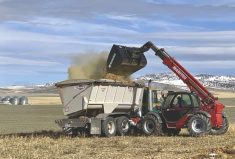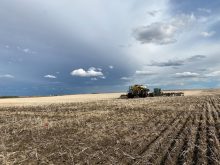When agrologist Matt Gosling visited Chris Dennison in New Zealand he wanted to know how Dennison had become the world record holder for wheat production. Dennison answered the question in a simple word: replacement.
When it comes to soil nutrition, Gosling has a similar philosophy: farmers should be monitoring soil status and replacing the nutrients they use — simple as that. It is a practice that has fallen to the wayside, says Gosling, but one that should be revisited.
Soil nutrition is something that’s often put on the backburner, says Gosling. Since yields across the Prairies have been exceptional this year regardless of nutrient management strategy, he’s particularly concerned that a lot of growers aren’t taking soil nutrition seriously.
Read Also

Cancer agency reclassifies another herbicide ‘probably carcinogenic’
The WHO’s cancer research agency has now put atrazine, a herbicide well known to corn growers, in the same potential-hazard category where the agency put glyphosate.
“If we’ve been fertilizing for a certain yield and we’ve out-shot that yield for years, we’re really in a soil depletion trend,” says Gosling. “Farmers who don’t treat their soil like a piggy bank or a savings account are really going to put their farm in a tough position here in another five to 10 years of higher crop removal.”
But farmers haven’t had to take soil nutrition seriously. Better genetics and better agronomic practices — fungicides, growth regulators and variant-rate technology — mean that yields are high regardless of nutrient management strategies.
“In some instances, our concept or practice of fertility has been left 20 years behind where producers are still fertilizing for genetics, for yield expectations and for practices where their fertility hasn’t matched the advancement of all of those other things,” says Gosling.
“If we’ve removed a big crop,” he continues, “we have to replace that big crop with what we’re going to put in the soil this fall or next spring.”
Phosphorus depletion is a big problem all across North America, says Gosling. Nitrogen, on the other hand, is pretty much a renewable resource, so there’s less concern about nitrogen depletion.
From the Manitoba Co-operator website: Healthy soil the key to healthy profits
“The potassium situation across the prairies in the soil is fairly strong,” says Gosling. “There are some instances where it is definitely worthwhile putting it down, especially in different management practices where they’re taking off straw or hay as part of their production and we’re removing very high amounts of potassium.”
Sulphur is a very inconsistent nutrient in the soil, but Gosling says that it should be kept at a consistent rate, if possible.
When we look at the big picture, though, phosphorus is the one nutrient that has the most yield-limiting power over the long term. One bushel of canola, for example, removes about one pound of phosphorus.
“If we’re fertilizing with 30 pounds of phosphorus and removing 50 pounds of canola, we’re depleting our soil of 20 pounds of phosphorus,” says Gosling, who thinks phosphorus should be looked at a lot more intensely by growers across the Prairies. “We’re only going to be able to keep that up for so many years before our soil gets really, really tired.”
Gosling suggests regular soil testing and a simple Excel spreadsheet to track what has been put in and taken out. He recommends that producers review their soil tests and come up with a nutrient management plan tailored specifically to their farm’s needs. Now is a good time to begin planning for next year.
Melanie Epp is a freelance writer who specializes in writing web copy for small businesses. She is based in Guelph, Ont., and can be found online at melanierepp.com.
















